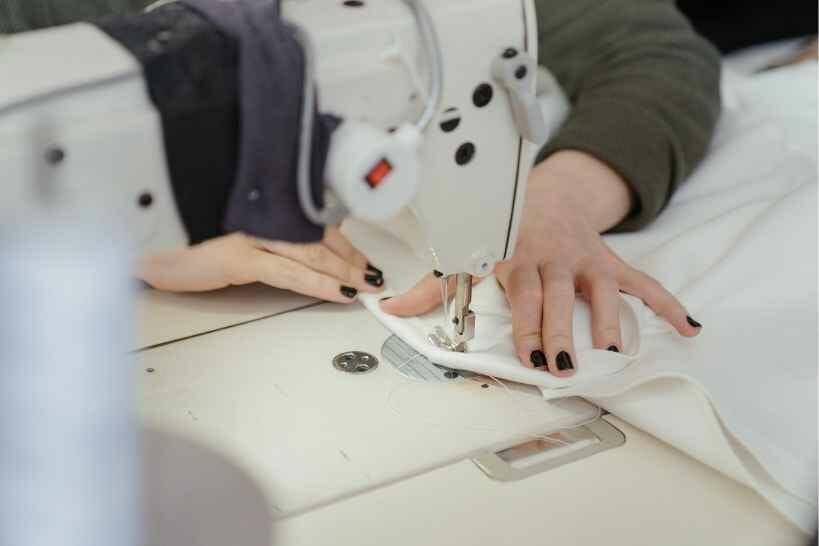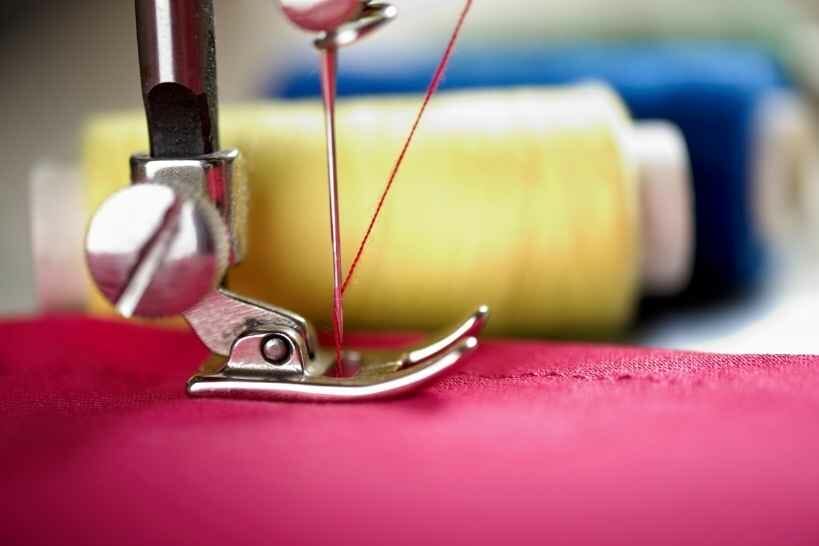Our Ultimate Guide To Fixing Upside Down Stitches From Your Sewing Machine
You’ve finally purchased your new sewing machine, turn it on and experiment with all its decorative stitches, only to find that your sewing machine has been stitching on the wrong side, what do you do?

Well, if your sewing machine has been stitching on the wrong side don’t panic, this is a common problem if your machine has not been threaded properly and most of the time can be fixed by simply rethreading your machine.
To help you solve and troubleshoot why your sewing machine has been stitching on the wrong side, we’ve composed an informative guide below which will cover why this happens, how to thread your bobbin right and find the correct tension, other issues and some tips.
The Most Common Reason For Stitching Upside Down
Finding out that your sewing machine has been stitching on the wrong side of your fabric can be embarrassing, but easily remedied too.
The number one most common reason for this stitching issue is when the machine’s bobbin has not been threaded correctly, with either the top or bottom being too loose, meaning it forms a stitch on the underside.
We’ve gone into some further detail about the common reasons why your machine is causing this problem below.
- The machine is not threaded correctly – Bobbin thread that is inserted the wrong way or bobbin tension too tight or loose can lead your thread path to be upside down. Small messy thread loops on either side or one side are an indicator of this.
- The needle is not right – Another less common reason as to why your stitches are on the wrong side is if you are using the wrong needle, this can cause bad thread stitches and an upside-down issue.
- Your bobbin might be upside down – The simple issue of your bobbin being inserted the wrong way can cause this key issue of stitches on the wrong side of your material.
- Decorative stitches & threading – Lastly, if threading for a decorative stitch with a presser foot, you may have threaded your decorative thread without letting the presser foot come to the top, meaning it didn’t enter all of the holes.
Can You Stitch Upside Down On Purpose?
If you feel like getting creative with the decorative thread you could always try sewing on your fabric in upside down for patterns.
You can do this by using the split stitch option on your machine, which allows the front of your fabric to mirror the back.
How To Thread A Bobbin Properly On A Sewing Machine
One of the most common causes of your sewing machine stitching upside down is due to a bobbin that isn’t threaded properly.
We’ve taken you through how to do this process down below.
- Start by loading your spool into the upper spool pin, and place any felt to stop the vibration inside.
- Pull the bobbin thread through the thread guides to put tension on the thread, and wrap it as your manual states.
- For bobbins with holes, thread the inside to the outside and place it on the bobbin winder spindle. For solid bobbins, simply wrap the thread around a few times and leave a small part of the thread hanging over the top.
- Now engage the bobbin winder (this will depend on your machine) and power it up to wind the bobbin, hold on to the thread tail if yours has one, most sewing machines will automatically stop the brake when winding.
- Now insert the bobbin into the machine, this can be vertically or horizontal, for vertical remove the casing and pull the thread through the slot, ensuring the bobbin spins smoothly. For a horizontal bobbin remove the needle plate and drop the bobbin in, pull the thread through following the guide on the machine.

How To Adjust The Tensions Of Your Sewing Machine Thread
If you are still getting upside-down stitches on your machine the problem likely will be to do with the bobbin tension and thread tensions, this can cause all kinds of issues such as missed stitches, skipped stitches and stitches on the wrong side of your fabric.
- Check pre-tension issues – Before going in and adjusting the tensions of your threads make sure it’s nothing to with pretension issues, this could be a bad needle, bad quality thread, a damaged bobbin pin or a blocked tension disc.
- Test your tension – To figure out whether or not you having issues with your upper or bobbin thread you can try a test sew, simply fill the bobbin and upper threads with different colored threads then check each side of the fabric. A red thread with black loops would mean the upper thread is too tight while loops on the bottom side mean the bobbin tension is tight.
- Adjust the upper thread tension – You can adjust your upper thread by moving the dial to a higher number to make it tighter or to a lower number to make it lose, the threading should feel balanced and smooth when set right.
- Adjust the bobbin tension – For a front-facing bobbin, you can check the tension by removing the bobbin from the machine and its case, holding the thread and then dropping the bobbin case over a soft surface, if it falls more than a few inches, the tension is too loose. For a top-loading bobbin, you will have to adjust the tension by adjusting the upper thread tension.
How To Perform A Zig Zag Stitch Properly (Without Going Upside Down)
Whether you want to do a zig zag stitch for seam finishing, applique or mending, zig zag stitching is easy once you get the hang of it, just always make sure your thread tension control is balanced before starting your stitch.
- To begin, thread your sewing machine correctly and set the machine to zig zag stitch, choose the length and width of the stitch, a good standard medium zig zag stitch is a width of 5.0 and length of 2.0.
- Now place your fabric under the presser foot and gently lower down the foot, hold loose thread’s ends while sewing to prevent them from getting stuck in the feed.
- Check your fabric and adjust any length and width of your stitches before you start sewing the real fabric.
Other Common Stitching Problems With Sewing Machines
If you are new to sewing machines or only just getting into decorative stitching, sewing on the wrong side of the fabric will likely not be the only problem you will face while sewing in the future.
To keep you prepared, we’ve listed some other common stitching problems you could run into below.
Thread Breakage
Thread breakage can be a common issue when sewing and is caused by looping threads around the spool, poor quality thread or jerking while sewing. It can typically be solved by threading the machine properly and using a better thread.
Missed Stitches
Spotting missed stitches can be disappointing when sewing, it’s often caused by beginners who do not put enough pressure on the foot when sewing or the need has been installed the wrong way in the machine.
To remedy missed stitches you can simply change the needle and insert it correctly or try increasing the presser foot pressure as you sew.
Machine Jams
Thread or a broken needle can jam your machine while sewing, simply cleans the bobbin regularly to avoid jams and blocks in the future.
Puckering
Puckering may occur during decorative stitching if the thread tension is too tight, the stitch length is too long or the zig-zag might be too wide for the fabric. You might need to re-balance the tension to fix this or change the stitch to a shorter length.
Stitches Bunching
If you find that your stitches keep bunching at the start then you could be sewing too fast without letting the foot down gently enough or you are not allowing the fabric to feed with enough freedom.
Fabric Is Not Moving Forward
It can be frustrating to set up your machine, only to find that the fabric is not moving forward as you are sewing, this is mostly due to the feed teeth not being raised or the stitches getting bunched in your work.
You can raise the feed teeth to fix this or try to increase the stitch length instead.
Tips For The Best Decorative Stitching
Starting to decorative stitch as a beginner can be overwhelming, to avoid mishaps, we’ve thrown together a couple of our best tips below to avoid common stitching issues and get the most out of your machine.
- Use the right machine foot – For the best results with decorative stitching and no loose threads, you need to make sure that you are using a satin stitch foot that glides over any type of decorative stitch with ease.
- Prevent puckering – Having a stabiliser underneath the fabric that you are sewing can help to stop it from puckering. We also suggest loosening your thread tension slightly and sewing slowly.
- Do a sample piece – Decorative stitches can be hard to pick if you haven’t tried them all yet, it’s best to see a few practice stitches before picking your pattern so you can avoid ruining your fabric.
- Use the reverse button – The reverse button comes in handy when you want to professionally lock off a decorative stitch, this allows you to end your stitch at any point.
Frequently Asked Questions About Sewing Upside Down
Why is my sewing machine stitching backwards?
Most of the time, this could mean the reverse stitch button on your machine is broken, so the thread is stuck sewing in reverse or your feed dog could be blocked with fabric and lint causing it to get stuck and sew in reverse.
How do you know if bobbin tension is too tight?
When removing your bobbin and its case from the machine the bobbin should be able to drop a few inches, if it can’t then the tension is much too tight.
What are the most common reasons for sewing upside down?
The most common causes of stitches on the wrong side are; the machine has not been threaded right, your using the wrong needle or thread, the tension is too loose or you could have let your presser foot up to fast when threading.

When should I do a straight stitch or zig zag?
This entirely depends on what you are sewing, straight stitches allow for a more uniform look while zig-zag stitches are better for a stretchy seam and appearance.
Can the type of thread cause bad stitches?
A poor quality thread matched with the wrong needle can indeed cause bad stitches since the machine will not be able to sew properly, it may also result in thread breakage.
Last Words
Overall, if your sewing machine is sewing upside down then it’s likely because the top thread tension is too tight or the bobbin tension is too loose, both can be fixed by simply readjusting the tension.
As well as checking the tension you should also consider the type of needle and thread that you are using, these can all have a huge impact on how your machine stitches.